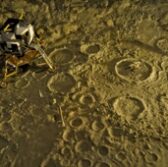 Researchers from NASA and Johns Hopkins Applied Physics Laboratory have created a geologic map of Ganymede, one of Jupiter’s ice-encrusted moons that were discovered by Galileo Galilei.
Researchers from NASA and Johns Hopkins Applied Physics Laboratory have created a geologic map of Ganymede, one of Jupiter’s ice-encrusted moons that were discovered by Galileo Galilei.
The scientific team was led by Wes Patterson of APL and Geoffrey Collins of Wheaton College in Massachusetts and used images sent from NASA’s Galileo and Voyager spacecraft to produce the Ganymede map, APL said Wednesday.
“By mapping all of Ganymede’s surface, we can more accurately address scientific questions regarding the formation and evolution of this truly unique moon,†Patterson said.
“Ganymede also shows features that are ancient alongside much more recently formed features, adding historical diversity in addition to geographic diversity,†Collins added.
The map provides information on the Ganymede’s surface, internal evolution and dynamical interactions with other Galilean moons, according to APL.
APL says Ganymede is 3,280 miles in diameter and known for generating its own magnetic field.




